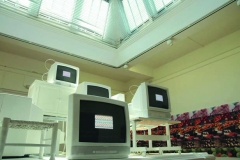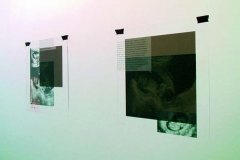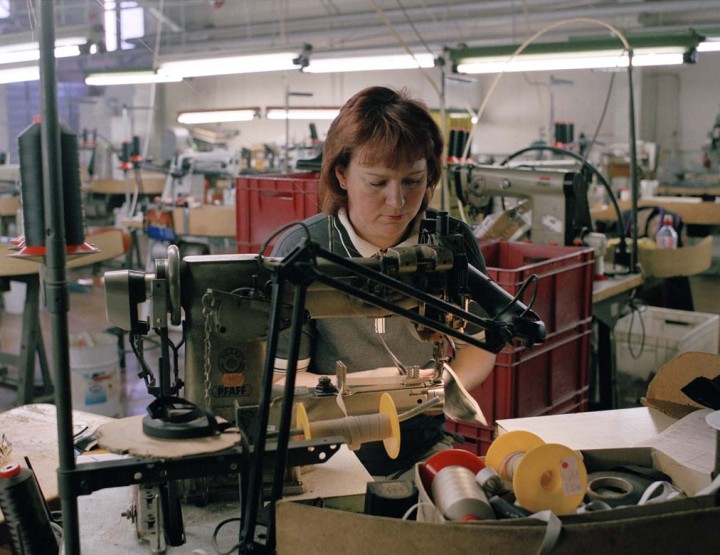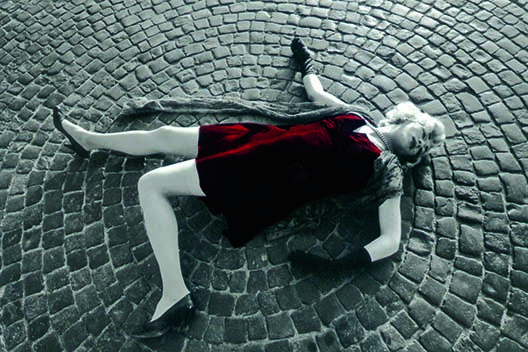Liina Siib (LS): To begin with, can you tell me something about your background, studies etc.?
Olga Jürgenson (OJ): my first art school was in Jõhvi [a town in north-east Estonia]. It gave me a very good start I think, people were very supportive there, and after all these years we still keep in touch. I still speak on the phone with my former teacher (Margarita Ostroumova) every so often when I am in Estonia. In 1984 I was accepted into the Secondary Art School in St Petersburg (Leningrad then). It was like a normal secondary school, but with a lot of art lessons added. I started when I was 15, and finished at 18. I was very determined to get in there and knew what I wanted.
LS: You wanted to become an artist?
OJ: Yes, and a “proper” one. I wanted to be able to draw and paint academically, because I thought that if some people were able to do that, then I had to learn to do that too. Then there was the Academy, the Ilya Repin Institute in St Petersburg, and its graphics department. The competition to get in was very tough; some people tried five or six times, year after a year, so I was quite proud to be accepted in my first attempt. It was interesting in the beginning, thanks mainly to printmaking: we could learn different skills and techniques, but in the middle of the third year I became rather bored.
LS: To me, the biggest problem was that we were not allowed to think on our own. We were kept busy doing everything, fulfilling the curriculum requirements, working all the time.
OJ: I see. Yes, thinking was the last thing the system wanted us to do. I was given great training in terms of skills during the first three years, and it’s a shame that I barely use them now. Although, more recently… yes, actually, I do, as I started painting again and feel quite excited about that.
LS: In the late 1980s Russian avant-garde art was starting to be shown again in the art museums of the Soviet Union.
OJ: Yes, and it was exciting. I remember a big Malevich exhibition that was great, definitely influenced me, as well as works by Matiushin and Kandinsky. Also, I remember a big exhibition by Filonov and his followers, and of course there were many combined, group exhibitions of Russian avant-garde.
Also, since we are still talking about influences: in the mid-nineties, I was introduced to Ivan Gurin, who became my mentor for a while. He certainly was a great support then.
LS: It is very important that these types of non-institutional kinds of working relationships exist.
OJ: Absolutely. It was very important for me.
LS: Then you had some residencies abroad?
OJ: The very first experience was the three-week International Symposia in Finland in 1993, which absolutely blew my mind. One of the most important ones was probably a residency in Vienna, which I was awarded in 2000. It enabled me to stay there for three months (and then for another three months in 2001). It was a great opportunity to be paid for just being there, seeing exhibitions at museums and galleries, meeting other artists from all over the world, and in the end producing and exhibiting a work. It was probably my first proper insight into the art scene of a Western country. In 2002 I was invited to take part in one of the exhibitions of the Liverpool biennial in the UK, and I ended up staying in the country. I was given a visa labelled Artist. Sometime later, when I was trying to get “a proper job”, usually rather unsuccessfully, I said to myself: “who am I kidding? Even the British government thinks you are an artist!”
LS: You have become part of the art scene in Britain. How has the UK influenced you as an artist?
OJ: In the beginning, I was extremely excited about the richness of the contemporary art scene I was able to experience, especially digital art and all sorts of cross-disciplinary variations; also, community-based art I found quite intriguing, a totally new thing for me then. I remember it reminded me of the quote by Lenin “Art should belong to the People”. I have been there for 12 years now. Gradually everything became familiar, normal, but the great thing about the UK, and London in particular, is that there is always tonnes to see, and often you can see real gems.
In the very beginning, I was lucky enough to become a resident artist at Peterborough Digital Arts. As a town, Peterborough is not particularly remarkable, but it was very interesting in the sense that there was a very big community of migrants from Eastern Europe, and it was growing rapidly then. I had the idea of producing a work on migrants and PDA supported it. I applied for a grant from Arts Council England and was successful; that’s how the Go West! project came about.
The exhibition Go West! in the Peterborough Art Gallery was a major outcome of my research. I built a sculptural installation from TVs and TV tables, painted them all white with wall paint, so the objects would become “as one” with the plinth and radiators attached to it. There were bright colour photo prints of food, imitating conveyor belts, and wallpaper on the walls, as I wanted to represent elements of the life and homes of migrant workers who had to work at conveyor belts for at least eight hours a day and who could only afford second-hand furniture. And, of course, the karaoke version of Go West!, which was played simultaneously on 16 TV screens. In Hainburg (Austria) and in various other venues, this karaoke video was projected on a wall, and a microphone and speakers were installed, so the audience could participate, sing along, and they did.
LS: You made a series about workers’ clothing. How did that come about?
OJ: It was one of the ideas that I had during my research on migrants. I had come across a fascinating trend in fabric design in the early years of the Soviet Union, specifically between 1927–1933, when the Communist leaders tried to turn the country into some kind of modern, mechanised utopia. There were a lot of abbreviations, such as CCCP (USSR) and VKPB (All-Union Communist Bolshevik Party), images of tractors and hammers and sickles for example, that were used in the fabric designs.
LS: Like mobile propaganda.
OJ: Yes. Imagine sleeping on sheets with VKPB on them? Or wearing a dress all covered with images of tractors and young pioneers. Nice! For my works, I used normal protective clothing used in factories. The designs I stencilled were meant to relate to the jobs the migrant workers did.
LS: There was also a miners’ theme. Could you tell me a little bit about your collaborative work with Mare Tralla: When Estonian peasant meets Russian miner.
OJ: Well, as you know, when the Bronze Soldier was moved in 2007 in Tallinn, the situation was quite tense in Estonia. Mare and I both wanted to do something about it. I suggested that we do some research on our stereotypes – Estonians about Russians and vice versa – so we both came up with a list each, and then used those lists to develop the installation. It was divided into three parts: one part was Mare’s wall, where she arranged some printed quotes from our e-mails, copies of photographs, her early drawings etc. I provided her with the requested materials, but didn’t take part otherwise. For my part of the installation, I bought some second-hand armchairs and TV tables with TVs, and arranged them in a way that if people sat in front of one of the two TV screens they wouldn’t be able to see the person sitting in front of them, because the TV screen would block the view. There were Russian TV channel broadcasts on one of the TVs, and Estonian channels on the other. To add to the domestic atmosphere of that common home, I also painted two paintings, pastiches of The Potato Eaters by Van Gogh; they also represented two different families: of an “Estonian Peasant” and of a “Russian Miner”. I added the elements from our research lists to my pastiches of Van Gogh’s painting. The title for the installation was Spot The Difference! What I was trying to say in my work was that we were in fact very similar and living in the same small country (i.e. house), but we were constantly being brainwashed by the media of two different governments. Plus, of course, stereotypes always “helped”, our common Soviet past etc. etc.
And, of course, there was a video, which was filmed at Mare’s allotment in London, and we both performed there, dressed as a miner and a peasant, chasing each other with a hammer and a sickle respectively, accompanied by the theme from the Benny Hill films.
LS: What about the collaboration with the Freud’s Dreams Museum in St Petersburg?
OJ: The title of the series I exhibited there was We are Made of Dust; it’s a part of a quote from one of the descriptions of Freud’s dreams. The theme was based on my research during a residency at the Addenbrooke Hospital in Cambridge, where I collaborated with molecular geneticists. Basically they provide a service for people who think there are some diseases running through the generations of their families; those people can come to the hospital and have tests done and see whether they are at high risk of transmitting those illnesses to their children and then they can decide what to do about that, whether to have children or not. Somehow it became connected with the iconic image of Black Square by Malevich; it’s ironic in a way that Russian contemporary artists seem not to be able to stop referring to Black Square, and I myself have thought sometimes: “how many more works will be done with that?” Yet, I decided to do something with that myself. Also, it was like coming back to myself in the mid-nineties, when I became fascinated by the Russian avant-garde. I used to read writings by Malevich then and quite seriously researched the subject. Also, I had a friend who was pregnant then and, looking at her, I thought that she looked totally like the Black Square, as there was one life inside another, one body inside another, which for me was quite directly associated with the black square being inside a white one. I also used some of Malevich’s words, in particular: “…a black square is an embryo…”. He actually said that, although I chopped the original sentence for a better effect. Somehow, there was also a connection between life and death. It became about our (human) life cycle in the end and, yes, my Black Square became a very Female Black Square.
This research and my interest in science gradually led me to a discovery of Russian Cosmism, which I am still fascinated by, and I continue working on the theme. There’s so much in it, a lot to dig into there and a lot to think about… I have already exhibited some of the works in group shows, one part in the Moscow Biennial last year, and others in Belgium and Germany. There was also a solo exhibition, Fedorov On Holiday, at the Youth Centre of the State Hermitage Museum in 2013.
LS: And now you have returned to the theme of food?
OJ: Yes, somehow food keeps “appearing” in my works. I guess you mean the very recent series of paintings and the installation Art Buffets. It was exhibited in a group exhibition of British artists at the Rizzordi Foundation in St Petersburg in May of this year (the exhibition was a part of the UK/Russia Year of Culture), and before that a couple of paintings from the series were a part of the exhibition “Dinner is Served” at the Russian Museum. So, the idea was inspired by different kinds of buffet food, which, as you may know, are often served at previews of art exhibitions. At a certain point, I decided to take photos of food and drinks at different openings and art-related parties, and I still take and collect them. Using selected photographs, I paint rather meticulous photo-realistic paintings. In the exhibition, they are combined with blank canvases (covered with satin enamel) and drawings on canvas, so each work consists of three or four canvases. Plus, there is a video, where the viewer can see my hand painting all the tiny details of canapés, with sound I recorded at a preview of an art exhibition. There is the juxtaposition of the quiet, slow and almost meditative process of painting with the noise of the exhibition preview, where you can hear visitors gossiping, discussing jobs, houses, relationships, which all altogether adds up to life!
Olga Jürgenson graduated from the Academy of Fine Arts in St Petersburg (Russia), and has lived in the UK, Russia and Estonia since 2002. She has participated in significant group exhibitions and residencies in Europe, Asia and Australia, including the Liverpool and Moscow biennials. She has received numerous grants and awards from several European foundations, and in 2011 was nominated for the Kandinsky Prize. In 2013 she had a solo exhibition at The Youth Centre of the State Hermitage Museum (St Petersburg, Russia), and is currently taking part in SALE, one of Manifesta’s 10 parallel programme exhibitions. http://www.olgajurgenson.net












